The main technical characteristics of shell rock
Density is the main indicator, strength, weight, and durability directly depend on density. The range is from 750 to 2300 kg / m3, and depends on the place of extraction. The "weakest" shell rock in terms of density is comparable to raw wood, and the most durable - with heavy concrete!

Blocks are sawn in standard sizes, although any are possible - on request. Standard - 380 * 190 * 188, weight from 10 to 25 kg, depending on the brand.
The lightest block M15 has a compressive strength of 15 kgf / cm2 and is used for one-story houses, garages, baths and any outbuildings, and small forms of improvement. M25 is quite suitable for the load-bearing walls of a two-story house. M35 grade is used even for basement parts of foundations and basement walls, with mandatory horizontal and vertical waterproofing.

The frost resistance of shell rock is not lower than that of red ceramic bricks - on average, 50 freeze-thaw cycles. And the shell concrete is 1.5-2 times faster in frost resistance than cellular concrete.

If you do not protect the shell from water and moisture, it will absorb water - up to 15-17% by volume. Exterior plastering or cladding is necessary, or during the rainy season, shell rock can contribute to the appearance of dampness in the house.

The temperature resistance of shell rock is low, slightly more than that of aerated concrete, and it is not suitable for lining chimneys.
Ecology is one of the main advantages of natural stone. Being a sedimentary rock of bottom sediments, the shell does not contain harmful impurities, on the contrary, it releases useful iodine and salts into the room. This plus can be minus by insulating the shell walls with expanded polystyrene. Basically, mineral and stone wool is used as a heater.
The geometry of the shell blocks is poor. The actual size usually differs from the declared size by 20-30 mm, if not more. For this reason, many builders prefer aerated concrete blocks, ceramic blocks and bricks. There are reasons - a lot of mortar really goes to masonry from shell rock, and there is also a large overrun on the plaster of uneven walls.

The cost of a shell is low only in a quarry after cutting, and delivery across Russia is very expensive, especially in the northern regions. A threefold rise in price can reduce interest in this unique building material, and this is understandable. It turns out more than twice as expensive as gas silicate concrete blocks. In addition, shell rock is fragile - especially M15 and M25, and it cannot do without a fight on transport. Damage and chips during unloading are also not uncommon. For shell rock, they usually go to the place of extraction and resolve all issues there, at the same time you can be convinced of the quality of the material.
The porosity of shell rock varies greatly - from 25% to 70% (in low-quality). The soundproofing and soundproofing of the shell wall is excellent.
In terms of manufacturability, everything is excellent - you can saw, cut, drill and groove, skip communications. The weight of the blocks is from 12 to 26 kg, no mechanisms are needed during operation.

Features of shell masonry
In blocks depends on its size and grade. The latter indicator can vary from M 15 to M 35. The number here means the indicator of the compressive strength of the material. If the compressive strength is low, the material will not be suitable for construction due to its fragility, and if it is too high, due to the high density of the material, the house will turn out to be too cold. The best option would be blocks with medium density. Moreover, it is quite simple to work with them: they can be cut with any hand tools.
Masonry from blocks of the Crimean shell rock can be done in three main ways:
- single row;
- two-row;
- three-row.
In each case, suture dressing must be done.
If a multi-row method of laying is used, spoon and butt rows should alternate in it. Single-row masonry, in turn, is carried out during the construction of a half-brick wall.
In all cases, special attention should be paid to the quality filling of vertical joints.
In some cases, solutions for masonry shells have to be poured into them from above.

A high-quality masonry compound is an important component of a successful construction.
When preparing it, in no case should you save. Any mistake can be fatal. If you are not confident in your own abilities, do not take risks. Entrust the preparation of the solution to experienced qualified specialists or purchase a ready-made mixture from a reliable manufacturer.
Shell rock is a natural material made up of the shells of marine animals. The closest place for its extraction and production for Russia is the Crimea. It was in the southern regions that he gained his popularity most of all.

Shell rock is a natural material consisting of the shells of marine animals.
Marble and limestone are also natural materials, similar in composition to shell rock, but their density is much greater than the latter.
Shell rock is great for making walls of houses, barns, foundations of various buildings.
Shellfish has been formed for more than one hundred years under the influence of external conditions from shells of mollusks that settle on the bottom. When it is mined, a red-brown, yellow or brown color of rocks is found, which easily lends itself to deformation when cut out. Despite the porous structure of the shell rock, it is strong enough and suitable for the construction of even three-story buildings. Excellent sound insulation and thermal conductivity are attractive qualities of this material during construction. A house or a structure built from shell rock will never have an excess amount of moisture inside. This is due to the fact that all its excess is removed through the porous walls of the shell rock.
The cost of a building erected from this material is much lower than the cost of a brick one, this gives additional advantages to the owner. In addition, in private houses, the attic floors are built from shell rock, since the attic should not be heavy.
Composition and main characteristics of the material
Shell rock is a limestone composed of calcium salts. Moreover, regardless of the place of extraction, the composition remains approximately the same: calcium carbonate - 52.06-55.66%, magnesium oxide - 0.19-0.71%, carbon dioxide - 41.16-43.62%. Under the influence of acidic water, calcium, which is part of the shells, decomposes, releasing carbon dioxide. This determines the presence of pores in the structure of the shell rock and the emergence of mineral springs. The main color is white-yellow, light yellow. Depending on the presence of impurities, the color may be different: iron gives the shell rock pink shades, copper - blue, coal - from gray to black.
Due to the fact that the shell rock was formed in the places of the former seas and from the remains of marine animals, it emits vapors of iodine and sea salt, has good antibacterial properties. In a room decorated with this material, a specific composition of air appears, strengthening immunity and strengthening health in general. It especially helps people with cardiovascular diseases and those who have problems with the upper respiratory tract, with the thyroid gland. Many resorts in the world are known for their coquina beaches with healthy air.
Shell rock is a natural stone, therefore it is an environmentally friendly material. Compared to others, it has a neutral background radiation of 13 μg / h, with the minimum allowable level of 25 μg / h. At the same time, it perfectly protects against dirty air, radiation and other harmful radiation by 100%.This is the only material capable of this.
Another very important advantage over other building materials is that mice and rats do not like a shell rock house. For a country house, this is a significant indicator.
The presence of pores is the reason for the low thermal conductivity of shell rock - 0.2-0.6 W / m-С °, while in brick - 0.55-0.64, more than two times more. The situation is the same with soundproofing. Therefore, the use of this material eliminates the need to additionally insulate and protect the walls of the house from noise, which gives significant savings in construction. In addition, the shell rock has a very high frost resistance - up to 70 cycles, so you can not be afraid for the integrity of the exterior decoration of the walls of the house, unless you go to change it yourself. Shell rock is very inert, therefore it does not react with other building materials, therefore, it will not collapse on its own and will not deform other substances.
According to their density, three brands of shell rock are distinguished:
M15 is the least dense, with large pores, very loose in appearance. It can be of different colors - from white to brown, but most often yellow, for which he received the nickname "yellowish". The yellowish tint is given by the presence of impurities of sand, which has a higher thermal conductivity compared to the shell rock itself. Therefore, this brand is the coldest among other brands. When hitting a hard surface, the M15 block breaks up into several parts. By weight, these blocks are the lightest (8-12 kg), therefore, during loading and unloading operations, their surface may be disturbed. Subsequently, in order to level the surface, it may be necessary to carry out a large amount of plastering work. Despite this, it is successfully used in the construction of garages, utility blocks, fences, baths, upper floors.
M25 is a shell rock with medium density and porosity. The main color is light yellow, sandy. If dropped, it rarely breaks in half, even less often into three parts. The most popular brand in construction, as it surpasses brick, gas and foam concrete in strength. It is widely used for the construction of two-three-story houses. In frame and panel construction, interior partitions are placed from this brand of shell rock. Block weight - 14-17 kg.
M35 is the densest and strongest grade of stone, has the lowest porosity. The color is almost white, yellow-white. The heaviest of all brands (22-25 kg), therefore ideal for laying a foundation, basement, basement. White shell rock is stronger than yellow shell rock.
Shell wall masonry
First of all, for laying shell rock, masons will need a plastic masonry mortar. With too hard a solution, it will be almost impossible to lay the shell rock exactly even for experienced bricklayers. A good masonry mortar should be easily pliable without flowing.
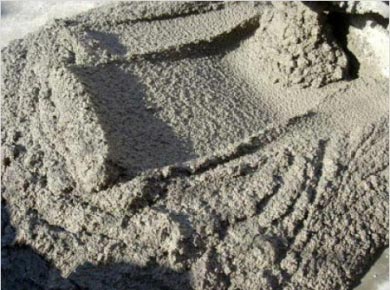 The optimal composition of the mortar for laying the walls of a house made of shell rock is as follows:
The optimal composition of the mortar for laying the walls of a house made of shell rock is as follows:
- 1 bucket of PC-400 cement; - 4 buckets of sand; - about 1 bucket of water.
If you mix such a composition without additives to the solution, then it will be excessively hard and unsuitable for masonry. If you try to fix this by adding more water, then the solution will quickly exfoliate and lose the desired plasticity. Therefore, it is imperative to use a special additive, which gives the masonry mortar plasticity.
An example of such an additive is DOMOLIT-TR. To prepare 1 m3 of solution, you will need about half a kilogram of such an additive. The exact dosage can be found in the instructions. If it is not possible to buy a special additive for masonry walls, instead of it, you can use ordinary liquid soap or detergent for washing in the amount of 10 ml per 1 liter of water to mix the solution.
With a masonry volume of 5000 shell rock blocks and more, it is advantageous to use a concrete mixer for mixing the mortar. Without it, the productivity of the bricklayer brigade will decrease, in fact, it will be necessary to allocate one auxiliary worker only for mixing the masonry mortar.Therefore, the concrete mixer will quickly pay for itself. In addition, it can also be used in the preparation of concrete and mortar for other work during the construction of a house.
If the volume of masonry work is small, then the mortar for masonry of shell rock can be kneaded by hand. It is most convenient to knead simply on steel sheet or any other durable, water-resistant surface.
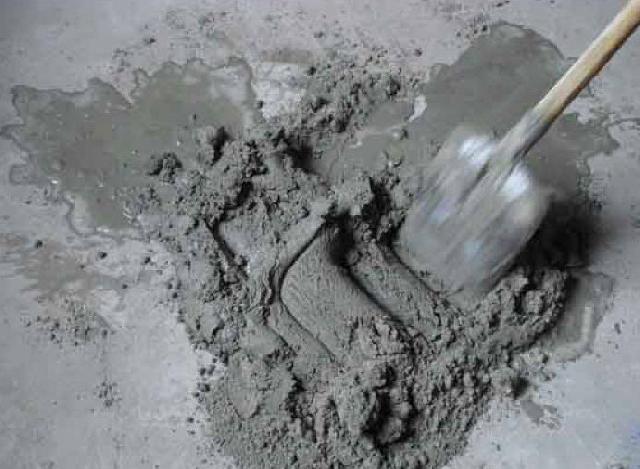
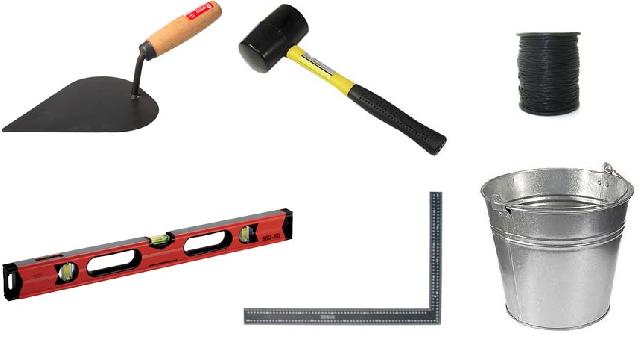
Building a shell rock house will require the following tools:
- trowel; - rubber hammer (mallet); - nylon thread; - building level; - measuring angle; - buckets for mortar.
Pay special attention to the quality of the building level. The accuracy of the masonry depends on this tool.
It is not recommended to buy cheap building levels with a flimsy bar. It is also best to buy steel buckets, plastic ones break quickly.
The laying of the outer walls of a shell rock house, like any other stone, starts from the corners. It is the most demanding, time-consuming and, without exaggeration, difficult work to bring out the corner of the walls exactly, especially given the poor geometry of the shell rock blocks. Therefore, only the most experienced bricklayers should be trusted to lay the corners. If you are going to make the masonry yourself without experience, then it is best to invite a bricklayer to show you how to do it correctly with the help of a building level.
When the shell rock blocks are correctly installed at the corners, it is relatively easy to lay a row between them. To do this, a nylon thread is pulled between the corner blocks (highlighted in red in the photo). The thread can be tied to two nails and secured by pressing down with a brick or half a block. It is undesirable to put a whole stone on fresh masonry, since it can press the moving mortar under the corner block by weight.
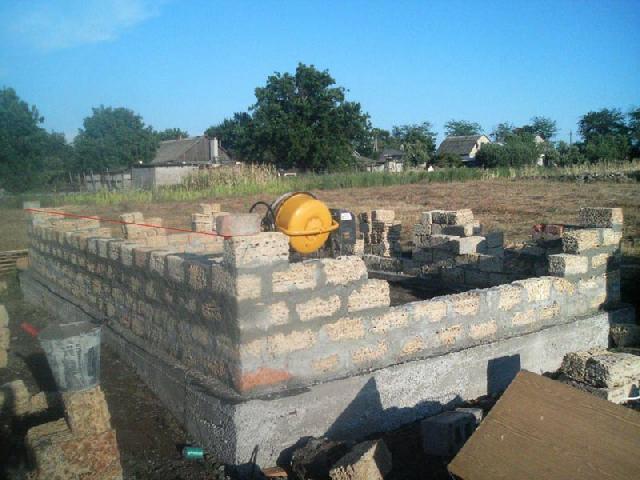
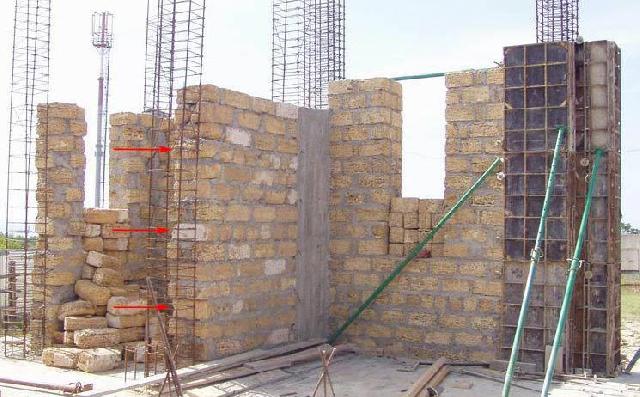
The block should be laid so that its upper corner "looks" into the thread, but not close, but at a distance of 2 mm. If you put the block close, then the thread is pressed through and the row will turn out to be an arc. Leading the masonry along the thread, you will never go wrong.
When laying a wall of a house with a width of one stone, the laying should be ligated every fourth row. The dressing can be done either by laying a row of blocks with a poke, that is, across the wall. Or by laying a 50x50x4 mm masonry mesh in the seam. The bandage binds the wall of the house, makes it more durable, a single monolith.
How many blocks do you need?
The dimensions of the stone in the construction market may deviate by 1-2 cm.However, the standard sizes of the shell rock block are 0.18 * 0.18 * 0.38 m. To erect one square meter of a wall in one stone, about 0.4 m is needed, depending on joint width with a mortar of 25-30 blocks. If the wall is half a block of 0.2 m, then 17-18 pieces will be needed. By the way, 1 unit of shell replaces approximately 8 bricks. The width of 1 block is quite enough for the Crimean weather, but the wall of a smaller thickness needs to be insulated along the facade.
Knowing the width, height, length of the house, you need to calculate the area of the house, subtracting the area of the holes in the walls - these are windows and doorways. Then multiply the resulting number by 25 or 18 pieces. As a result, you will receive the number of shell rock blocks that you will need when building a house.
Let's look at an example. Let's calculate the number of shells for a 1-storey building with walls 10 * 10 m 0.38 m thick.We take the height of the walls as 3 m.So, the surface area of all walls will be 3 * (10 + 10 + 10 + 10) = 120 sq m Let's take the area of holes in the walls for 10 sq. M. This means that the value we need is 120-10 = 110 sq. M. We multiply it by 25 blocks. We get 2750 pieces. This is the right amount of stone.
In the same way, we calculate the amount of shell rock for internal partitions.
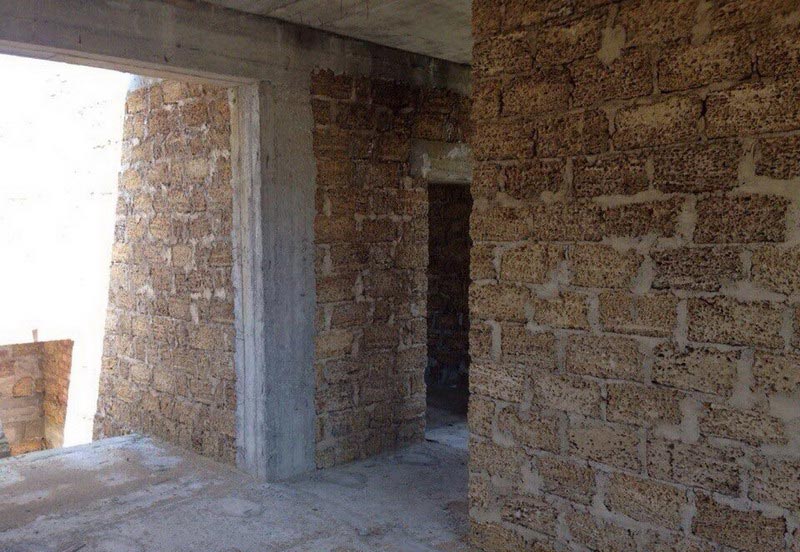
Shell rock: composition and types
Shell rock is not a "full-fledged" stone, it is a natural fossil, although in many sources it appears as a kind of natural stone. The material was formed from the remains of marine life that existed in ancient times.
What does it consist of?

Most of all, shell rock is similar in composition to limestone. It has:
- calcium carbonate, it takes from 52 to 56%;
- carbon dioxide, imparting porosity to the stone (40-60%);
- magnesium oxide (1-2%), due to which the shell rock has a sandy color.
Different shades of material from different deposits are explained by different impurities - other fossils characteristic of a particular region. For example, coal "gives" shells a gray or black color, iron - pink, copper - bluish or blue.
Varieties of shell rock
The strength of the shell rock also varies. It only depends on the percentage of lime and sand. If the latter is larger, then the material will be more fragile. Shell rock from each deposit has its own unique composition due to the different percentage of the main components.
Stamps
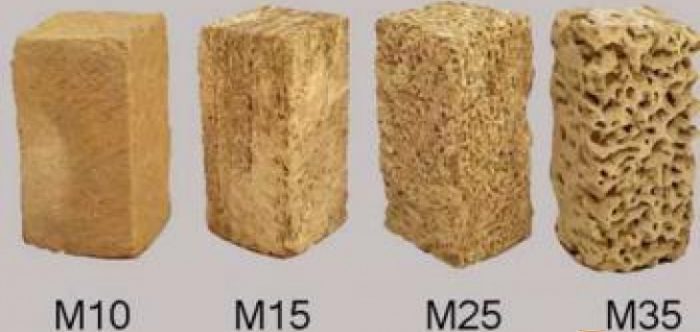
There are three main brands that are popular in construction: M15, M25, M35. M19 is practically not used due to its looseness.
- M15. This is the most porous species, containing the maximum amount of sand, which means a small percentage of lime. Its disadvantage is fragility: when falling from a height, such a stone is destroyed. The M15 is characterized by a light yellow color, lightness. Such shell rock is suitable for the construction of fences, small outbuildings with 1 floor.
- M25. This is the most suitable material for the job. There are fewer pores in it, so the density is higher. Shell rock of the M25 brand is capable of retaining its structure when dropped. This variety has a yellow-gray color. It is used in the construction of load-bearing structures of buildings with 1-2 floors, as well as partitions in multi-storey buildings. The maximum number of floors allowed is 5.
- M35. This material has a minimum number of air cells, so it is durable and dense. When dropped, such a stone does not split, remaining unharmed. Thanks to these qualities, the M35, unlike other types, has significant weight. It is chosen for the construction of load-bearing walls, for the construction of foundations, plinths. Due to its severity, it is rarely used in the construction of multi-storey buildings.
There is another brand - M20, it is sometimes used for the construction of one-story houses and interior partitions, fences. This shell rock is denser than M15, but its sand content is lower than in M25. The color of the stone is yellow.
Block weight

At any stage of construction, when choosing materials, attention is paid to their weight. For shell blocks, it differs depending on the brand:
- from 15.4 to 18.5 kg - for M15;
- 23.3 - 27.5 kg - for the M25;
- from 29.3 to 35.1 - for M35.
Decorating the house with shell rock, both outside and inside, involves the use of low-porosity grades - M25 or M35. It is better to take those materials that have a higher percentage of sand. In this case, after facing, the shell rock can be protected without any problems with a facade varnish, which can become an obstacle to moisture.

Building a house from shell rock
The durability and reliability of the shell rock does not need confirmation. In the Crimea, in the North Caucasus and even in the cities of foggy Albion, there are structures made of shells - not destroyed! - that have stood for hundreds, and even a thousand years. The material from a natural conglomerate, lime shells of shells of ancient mollusks that lived in the sea millions of years ago, is surprisingly resistant to weathering, frost and heat. Frost resistance of dense grades is about 60 - 80 cycles, thermal conductivity is low, and heat resistance is high. In terms of fire, shellfish is safe and itself for some time serves as a barrier to fire. But we must remember that in the constructional "cake" of the walls there will be more than one shell, so insulation and finishing materials should be chosen accordingly.


Features of shell masonry
There is perhaps only one difference from the technology of masonry made of lightweight concrete blocks - it is more difficult to lead a wall of stone with a spread in geometric dimensions, and the spread reaches 30 mm and more. In addition to the overrun of mortar for joints, the thickness of which is required at 20-30 mm in order to level the rows, there is still a question with the mortar itself. A solution with very good plasticity is needed, but dense, therefore plasticizers are used in large doses.Laying is carried out as usual - from the corners along the lighthouse cord and with horizontal and vertical alignment. The thickness of the walls is taken at one or one and a half stones. Walls with a thickness of 580 mm do not need an additional layer of insulation, they are only plastered. For internal non-bearing partitions and walls of outbuildings, masonry on the edge is sufficient - 180 mm thick.

It is impossible to leave shell walls without external plaster for autumn and winter; drainage from the roof must also be solved without delay. Roof overhangs and canopies are made large - 60 - 70 cm.

On the issue of armored belts, everything is decided individually and depends on many factors - the number of storeys of the house, the seismicity of the construction area, the properties of the soil and the brand of the shell, and of course, it is linked to the width of the masonry. The need for a basement armored belt is more a question of the foundation, if there is a plate at the base - the lower armored belt is not needed. But under the overlap and the Mauerlat, the armopoyas is often poured, since the shell is still a fragile material. The stone of the M35 brand can withstand both the weight of two floors and the reinforced concrete version of the floor. The M25 grade also withstands reinforced concrete hollow floor slabs, but still builders often decide on the need for an armored belt. As an option, they arrange reinforcement by casting the columns in the corners of the house and combining them with an armored belt. This option gives the house even more architectural expressiveness.

Shell wall masonry video
Watch a video about the laying of shell rock:
If you are building the first floor of a residential building, then it is better to put the shell not in the floor of the stone, but in the stone. And the upper floor can be made already in half a stone, only in this case, it is highly desirable to insulate the building. You can use polystyrene foam as insulation.
Watch a video of shell masonry walls for example:
If you have never laid a stone, then it is better to contact a specialist, there you can save on finishing, tk. the smoother the stone is laid, the less plaster layer will be used for finishing.
On the lower floor, it is better to use a denser shell rock, for example, the M-35 brand. For the upper floors and laying of walls in high-rise buildings, you can use the stone of the M-15 and M-25 brands.
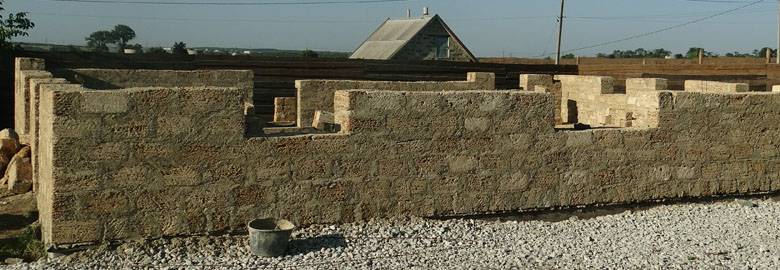
It is highly desirable to reinforce every third or fourth row in order to strengthen the structure. Do not skimp on mortar when laying shell rock.
Usually the solution is formed according to the following proportions: 3 portions of sand for 1 portion of cement - diluted with water to a plastic appearance. It is forbidden to lay shells in frost.
Requirements for the foundation for a shell rock house
The shell rock has a lot of weight, despite the pores in it. Accordingly, the foundation must be solid. You can use a monolithic reinforced concrete tape. Limestone itself is not suitable for the foundation because of its hygroscopicity. However, it is possible to build a base from recrystallized shell rock. Its density is high, the material practically does not absorb moisture, but it is difficult to process. It's almost impossible to cut or break it.
When installing the formwork, it must be borne in mind that the basement must be higher than 40 cm. In addition, high-quality waterproofing of the foundation is necessary, the shell rock must be protected from constant moisture ingress.
Calculating the construction of a garage from a shell: calculator
How much stone will it take to build a garage? Let's make calculations taking into account that the shell stone has the following size: 390 x 190 x 190 mm.
Usually a garage is built with one block with a wall thickness of 38 cm. That is, the stone is laid along the length. In this case, about 30 shell rock blocks (1 / (0.18 * 0.38) * 2 = 29.2 pcs.) Must be taken per one square meter without taking into account the seams.
Let's count on an example. Let's say you need to build a standard garage with a minimum wall size: 3 by 6 meters. The height of the walls is 2.2 meters. The perimeter of the outer walls of the garage is 18 meters. Therefore, the wall area is 39.6 m2. Subtract the size of the gate from this figure. Let's say they are 5 m2. Received 34.6 multiplied by 30. We get 1038 pieces of shell rock for building a garage.
If it is necessary to erect partitions in order to separate the utility block, then the calculation is carried out in almost the same way. With the difference that half of the block is taken - 18 cm.The required number of shells per square will be 15.
Shell rock masonry tools
For work we need:
- level;
- roulette;
- Master OK;
- hammer;
- solution bucket;
- shovel for mixing the solution.
It is more difficult to find the correct masonry of shell rock than a woman with an ideal figure. This article will primarily be useful to those who will build buildings from shell rock on their own, by the forces of involved builders and for bricklayers who have no experience in working with the Crimean stone.
In the overwhelming majority of cases, when buying a shell rock or shell rock, buyers unreasonably purchase a higher grade of stone than is required for their buildings, explaining this by the fact that "I want it stronger and more reliable." But after the purchase, during construction, building codes and rules are completely ignored, relying on the margin of safety of the stone and the experience of masons and thereby nullifying the purchase of a more durable stone. In the absence of insulation: the unjustified use of a more durable stone than required, leads to a deterioration in the thermal properties of the building, and entails an increase in heating costs.
So, about the correct laying
The strength of the masonry is influenced by many factors: the method of dressing, the strength of the stone, the composition and mobility of the solution, the temperature and humidity conditions during construction, the method of applying the load, the speed of loading with the load after the completion of the work, the quality of work on the arrangement of the masonry, deviations in the horizontal and vertical projections. All these factors are strictly regulated by building codes.
Methods of dressing for laying a stone of shell rock (shell rock)
Consider the first factor - a method of dressing for laying small-block from natural stones. The building codes give direct instructions on the length of the overlap of the masonry stones and, in part, on the methods of dressing:
1. The overlap of one stone relative to another must be at least 1/4 of the length of the smallest element.
2. The seams of the masonry in any direction are limited in width from 6 to 15 millimeters.
3. With all methods of dressing, the first row must be poked, it is also obligatory to lay the butt row under the overlap elements.
4. Vertical and longitudinal vertical joints of wall masonry in lintels, walls and pillars must be filled with mortar.
5. Nowhere are there any direct instructions on limiting the height of spoon masonry, however, the current building codes until 2010 and still in force in the Russian Federation require the fulfillment of the condition - in every three rows of masonry, one row is bonded. The first condition is fulfilled even with a maximum seam thickness of 15 millimeters and is 8.25 cm, which is more than 4.25 cm of the standardized. As the seam decreases, the overlap of the elements will only increase. This condition is fulfilled for both single-row and three-row unreinforced masonry made of shell rock and therefore does not require any additional measures to ensure the operation of the wall as a single structural element.
Single-row or chain dressing is one of the most ancient, strong and durable types of masonry used to this day. Three-row dressing system, maximum permissible; for unreinforced shell stone masonry. Dagger rows: 1, 4, 7, 10, ... etc. Spoon rows: 2, 3, 5, 6, ... etc. Laying butt rows is more time consuming in comparison with spoon rows, since it requires a bricklayer to fill vertical masonry seams to the entire height and length of the seam, and spoon rows do not require filling with mortar to the entire height of the seam, with the exception of posts, lintels and walls. That's the whole secret. The bricklayers, taking advantage of the developer's ignorance, simply cheat or persuade the client to motivate: "it stands everywhere and does not fall."
Do-it-yourself shell masonry features
The strength and reliability of the shell rock
The lightness of the shell rock makes a deceiving impression. It seems that such a stone will not withstand a large static load. However, the minimum grade of the mined shell rock - M10 - implies such a calculated load on one stone, which is an order of magnitude higher than that required for the stone of the lower row of a two-story building. That is, even with the minimum density of the shell rock, its safety margin is at least tenfold. Kharkiv Institute of Forensic Expertise. Bokarius conducted an examination of the strength and reliability of this material and received a positive result.
True, a less dense stone is bad because it crumbles during loading and unloading operations, acquiring an uneven surface, and this increases the consumption of mortar when laying the wall. Therefore, stones of grades M10, M15, M20 weighing 8-12 kg are best used for the construction of garages, baths, outbuildings, as well as third, attic floors of houses. M25 stone weighs about 14-17 kg and is best suited for the construction of 2-3-storey houses, even with reinforced concrete floor panels. Finally, a stone of the M35 brand weighing 22-25 kg will be a reliable base and is suitable for the construction of the first floors of buildings with a height of more than two floors. But it is rarely used, since it is not cheap, and the M25 grade is sufficient for most structures, especially in low-rise construction.
